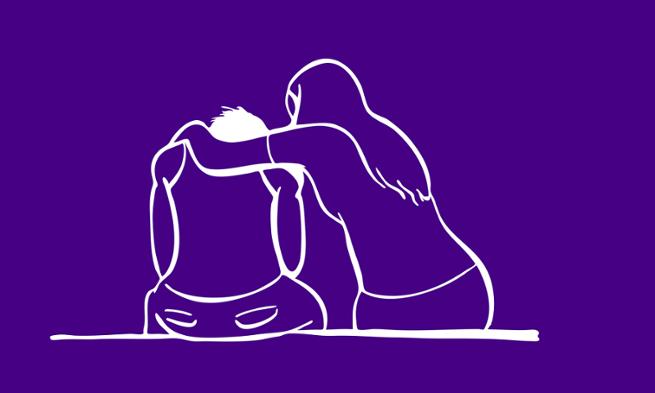Reducing the risk of suicide
News
By Maggie Siciliano
Be sure to read Finding Eternity on the Be the Change blog.
The Suicide Prevention Resource Center reports a sobering statistic: In youth ages 18-24, suicide is the third leading cause of death. Data suggests that among college students, 15 percent of graduate students and 18 percent of undergraduate students have seriously considered attempting suicide in their lifetime.
The numbers beg the question—why? General assumptions dictate that young adults are at a stage in their development brimming with life's possibilities and positivity. Shouldn't they be chasing dreams and enjoying their freedom rather than thinking suicidal thoughts?
'The question is...why?'
National trends implicated
Katrina Simpson-McCleary, a senior staff psychologist at JMU's Counseling Center and Coordinator of Suicide Risk Reduction Services, says that the center's staff identified two national trends seen at JMU that impact the ability to reduce the risk of suicide: stigma and alcohol use.
While society in general has become increasingly comfortable with counseling, there is still a very real stigma associated with mental health disorders, especially suicide. Asking if someone has had thoughts of suicide is difficult. Talking about suicide can be difficult. "The interventions that we are implementing on campus that raise awareness, that encourage us to check in with one another, and that help instill hope, are designed to reduce the stigma," she says.
"Alcohol use on a college campus has an impact on the number of attempted and completed suicides for several reasons. Alcohol acts as a depressant, which can cause someone who is feeling down become even more depressed. This, combined with the decrease in inhibition and inhibited ability to think through the consequences of our actions, increases the likelihood that a student will make a suicide attempt," Simpson-McCleary says.
'Slow down a bit and engage in the world around.'

Finding solutions
Today's young adults, part of the Millennial Generation, are often characterized as technologically savvy, constantly on the go and doing everything at once.
"Too much exposure to stressful and anxiety-provoking situations can push us and our bodies past that optimal level of stress, which impacts our ability to be successful. Students in the U.S. are so busy, often multitasking, that simply encouraging them to slow down a bit and engage in the world around--go for a walk, have dinner with a friend without the phone—can have a positive impact on their overall stress or anxiety level," Simpson-McCleary says.
It is important that students who know of peers with suicidal thoughts do not keep the information to themselves. The stigma of "telling" must be erased. "It can be easy to fall into the confidentiality trap because 'good friends' keep secrets. But thoughts of, or plans to attempt, suicide are not 'secrets to keep' like having a crush on someone. We need to be clear about the potential consequences of not helping a friend get support by reaching out—that person's friend could die," says Simpson-McCleary. "Friends should encourage peers to seek out help. A large majority of college suicides occur among students who have not accessed counseling services. Being in counseling reduces the suicide risk by a factor of 20." Using the acronym C.A.R.E., the Counseling Center has outlined a series of suggestions for helping someone who is struggling with suicide.
'Saving the life of a student might come down to us having the right knowledge and being available in the right place at the right time.'
Providing a safe, supportive environment
In the interest of providing a safe and supportive environment, JMU has fostered a number of intervention efforts as well as outreach and community engagement.
Intervention
• Since one of the most important risk reduction strategies is to enhance physical barriers to means, the university recently completed barriers on the bridge over I-81 on Port Republic Road.
• The Counseling Center provides 24/7 emergency support for mental health crises.
• JMU Campus Police or Harrisonburg Police will execute welfare checks if there is concern that students may be at risk of harming themselves or others.
• The Center for Faculty Innovation makes At-Risk, an online interactive training tool by Kognito, available for faculty and staff members. At-Risk acquaints users on how to recognize signs of psychological distress and how to approach and connect a student with support services on campus.
Outreach
• The Counseling Center partners with the Center for Faculty Innovation on "Here to Help" training to faculty and staff, providing instruction and guidance about working with distressed students.
• The Counseling Center has a staff member dedicated to providing outreach to the university community on recognizing signs of distress and helping a friend get help. These presentations are regularly requested by professors and student organizations.
Community Engagement
• JMU has partnered with Bridgewater College, Eastern Mennonite University, Blue Ridge Community College, the Austin Frazier Memorial Fund, Sentara-Rockingham Memorial Hospital, and the Campus Suicide Prevention Center of Virginia to bring to fruition Walk for Hope, an annual event designed to raise awareness of depression and suicide and encourage hope. JMU hosted the main event in March 2013.
• Every year, the Counseling Center collaborates with other campus offices and organizations to host events during National Suicide Prevention Week.
• The student-run organization Active Minds empowers students to change the perception about mental health on college campuses.
• The annual Out of Darkness walk in the spring semester is coordinated by Chi Sigma Iota, an honors society for graduate counseling students.
The Counseling Center clinical staff encourages the Madison community to be aware that "saving the life of a student might come down to us having the right knowledge and being available in the right place at the right time." The center's staff stands ready to help regarding these issues.
